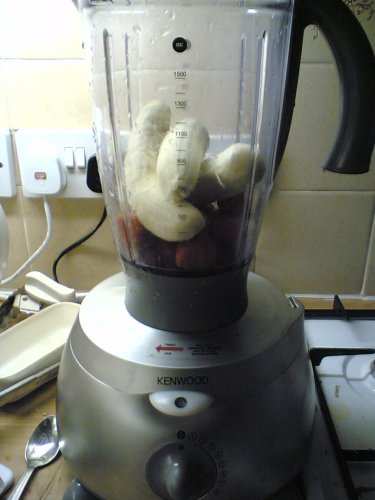Shake-ology Part One: Shake FAQ’s

You can make a shake with just a spoon and a glass, a hand mixer or a shaker cup, but blenders work best.
Protein and meal replacement shakes have gone mainstream in a big way. Once solely the province of bodybuilders and hardcore dieters, nowadays everyone drinks shakes. But it can take some practice and trail-and-error before you can truly be called a Shake Master. Here’s Part One of our Guide to Shake-ology; some FAQ’s and other pointers. In Part Two, which will post Friday November 7, we’ll post some recipe ideas.
Q: Why shakes at all? Why not capsules or tablets for nutritional supplementation?
- Shakes are a great way, maybe the best way, to get a lot of nutrition in one quick, convenient drink.
- Shakes can be enjoyed by the whole family since they don’t require swallowing capsules or tablets.
- Nutrients like protein, creatine, amino acids and many others are taken in gram quantities that would require a fistful of capsules or tablets.
Q: What’s involved in making a nutrition shake?
A: The most basic and simplest shake is a protein or meal replacement powder mixed in with water with a spoon. Which is fine in a pinch, but using a blender, some ice and the right ingredients makes a shake more nutritious and enjoyable to drink.
Hand mixers and shaker cups work, when you don’t have access to a blender. But we’ve found that blenders really are the way to go. They mix ingredients up the most thoroughly, and can handle enhancements like frozen fruit and ice cubes, which greatly improve the taste and drinkability.
They whole key to a good shake is thoroughly mixing up the ingredients. This is why blenders work best.
Q: My shakes always have clumps in them, what am I doing wrong?
A: Try adding the liquid first, then adding the powder gradually, preferably with the machine running. If you have a blender that lets you add ingredients through the lid while the liquids are mixing, all the better.
Q: I always seem to make too much and am wasting the leftovers, since there’s no one else here to drink them, and a shake doesn’t store well anyways. Any ideas?
A: Use your intended glass or drinking cup to pre-measure the shake ingredients and your liquid of choice, then add them to the blender. Allow a little room for expansion since blending introduces air into the mixture and fluffs up the volume of the shake.
Q: Which is better for me, the meal replacement powder or the protein powder?
A: You can use either one once you understand what the differences are. Protein powders supply mostly protein, very little carbs, very little fat and most do not have added vitamins or minerals. They primarily supply protein, and protein only, although many brands have added odds and ends like extra amino acids or digestive enzymes. Meal replacement powders, or MRP’s, are essentially beefed-up protein powders. Most have protein as their base ingredient, manufacturers then add other nutrients – vitamins, minerals, healthy fats, carbs, etc – to make them more nutritionally complete than just a protein powder, hence their name. Any person can use either one depending on what their needs are.
Q: Can I make a large batch of shake and store it for future use?
A: Theoretically you could, but ingredients tend to settle out to the bottom, requiring you to remix the shake before serving it. That defeats the whole purpose of time-saving. So, it’s best to use other methods to save time (see next question).
Q: I just don’t have the time to make shakes during the day when I’m at work. What can I do?
A: Shaker cups are a popular solution for this kind of problem. Just add the dry powdered ingredient(s) to the shaker cup and bring that to work. Then add water, juice or milk when it’s time for your shake.
Q: Can I use hot water or warm milk to make my shake?
A: Yes. The amount of protein in the shake won’t change, but you might lose some of the immune-enhancing properties of whey protein since heat can denature (change the structure of) proteins like those found in whey. The protein may also clump up, or settle out if mixed with warm or hot liquids.
Q: What’s the best protein powder? The best Meal Replacement Shake?
A: There really are no “bests”. Everyone’s got their favorites. The differences are many; flavor and taste, nutritional profile, cost and other factors. Even when you find one you like, you’ll get tired of it eventually and want a change. So for all of these reasons, most shake aficionados try different products to find their favorites and rotate through different flavors to keep things interesting.
Q: I’ve dabbled around with a protein powder or two years ago, but they were awful and I gave up on them.
A: We were there, too and we remember. But these products have come a long long way from the chalky, bland or oversweet protein and MRP powders of the past. The last 10-20 years have seen the arrival of new protein ingredients, sweeteners, flavors and production techniques that make it such that there really are no “bad” protein or meal replacement powders anymore. You might like this one more than that one, but don’t agonize over deciding. Stick with a well-known brand and a flavor you’re familiar with and you can’t go wrong.
- Posted in Miscellaneous
- 2 Comments



